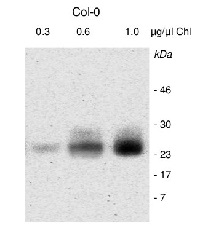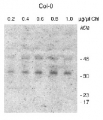1

Anti-PSB33 | Rieske (2Fe-2S) domain-containing protein
AS12 1852 | Clonality: Polyclonal | Host: Rabbit | Reactivity: Arabidopsis thaliana, Oryza sativa
- Product Info
-
Immunogen: Part of Arabidopsis thaliana recombinant TEF5 protein, corresponding to epitopes 61-242, UniProt: Q9C9I7 , TAIR: At1g71500
Host: Rabbit Clonality: Polyclonal Purity: Serum Format: Lyophilized Quantity: 50 µl Reconstitution: For reconstitution add 50 µl of sterile water Storage: Store lyophilized/reconstituted at -20°C; once reconstituted make aliquots to avoid repeated freeze-thaw cycles. Please remember to spin the tubes briefly prior to opening them to avoid any losses that might occur from material adhering to the cap or sides of the tube. Tested applications: Western blot (WB) Recommended dilution: 1 : 4000 (WB) Expected | apparent MW: 31 | 25 kDa (without transit peptide)
- Reactivity
-
Confirmed reactivity: Arabidopsis thaliana, Oryza sativa
Predicted reactivity: Species of your interest not listed? Contact us Not reactive in: Chlamydomonas reinhardii - Application Examples
-
application example
Specified µg/ul of chlorophyll from Arabidopsis thaliana leaf extracted with sample buffer (2% SDS, 8% sucrose, 0.2mM EDTA, 10mM Tris HCl (pH 6.8) 4% beta-mercaptoethanol) were separated on 15 % SDS-PAGE and blotted 1h to PVDF. Blots were blocked with 10 % milk for 1h at room temperature (RT) with agitation. Blot was incubated in the primary antibody at a dilution of 1: 4 000 overnight at 4°C with agitation. The antibody solution was decanted and the blot was rinsed briefly twice, then washed once for 15 min and 3 times for 5 min in TBS-T at RT with agitation. Blot was incubated in secondary antibody (anti-rabbit IgG horse radish peroxidase conjugated) diluted to 1:20 000 in for 1h at RT with agitation. The blot was washed as above and developed for 5 min with ECL West Pico (34080, Thermo) according to the manufacturer's instructions. Exposure time was 60 seconds.
Courtesy of Dr. Rikard Fristedt, Biophysics of Photosynthesis, Dep. Physics and Astronomy, Faculty of Sciences. VU University of Amsterdam, The NetherlandsApplication examples: 
Reactant: Oryza sativa (Asian rice)
Application: Western Blotting
Pudmed ID: 26552588
Journal: Sci Rep
Figure Number: 6A
Published Date: 2015-11-10
First Author: Dixit, G., Singh, A. P., et al.
Impact Factor: 4.13
Open PublicationWestern blot analysis of selected candidate proteins (AtpB, 2Fe-2S, GLN2, Psb R, PRK, ALD) with their corresponding molecular weight in rice leaves during As stress under various S regimes (A); RuBisCo large subunit a band in coomassie blue staining (CBB) SDS gel served as a loading control (B), which used for normalization of detected proteins in densitometry studies (C) fold change indicated with respect of control samples.

Reactant: Arabidopsis thaliana (Thale cress)
Application: Western Blotting
Pudmed ID: 28922769
Journal: J Exp Bot
Figure Number: 2A
Published Date: 2017-07-10
First Author: Fristedt, R., Trotta, A., et al.
Impact Factor: 6.088
Open PublicationPSB33 protein is mainly located in non-appressed thylakoids. Digitonin-solubilized thylakoid fractions (stroma lamellae (SL), grana margins (GM), and grana (G)) from wild-type plants acclimated to dark, low light (50 PFD), and high light (800 PFD) for 2 h were separated on an SDS gel, transferred to a nitrocellulose membrane and subsequently immunodecorated with an antibody against PSB33. A total protein stain (Ponceau) of the membrane shows that the same amount of protein was loaded and a clear protein-specific pattern of fractionation.

Reactant: Arabidopsis thaliana (Thale cress)
Application: Western Blotting
Pudmed ID: 28922769
Journal: J Exp Bot
Figure Number: 4C
Published Date: 2017-07-10
First Author: Fristedt, R., Trotta, A., et al.
Impact Factor: 6.088
Open PublicationReversible PSII-LHCII phosphorylation is defective in psb33 plants in fluctuating light conditions. Dynamics of thylakoid membrane phosphoproteins in response to fluctuating light conditions in wt and psb33. Thylakoids were isolated from plants at the end of the five dark–light periods (dark (Da1), low light for 2 h (LL1), high light for 2 h (HL), low light for 2 h (LL2), and darkness overnight (Da2)). On the left, a dilution series of dark (Da1) acclimated wild-type thylakoids shows the linear range of the antibody. (A) Immunoblot analyses of the PSII core (P-CP43, P-D2 and P-D1) and LHCII (P-LHCII) phosphoproteins from whole thylakoids were performed after SDS-PAGE. (B) Immunoblot showing the amounts of PsaB (above) and D1 (below) in the same samples as (A). Quantitative D1 protein levels, which have been normalized to Da1 D1 levels, are represented as numeric values below the D1 immunoblot. A Coomassie-stained PVDF membrane is shown as a loading control. (C) Immunoblots with specific antibodies against Lhcb1, P-Lhcb1, Lhcb2, P-Lhcb2, and PSB33 of whole-leaf protein extracts from wild-type and psb33 plants, highlighting the change in phosphorylation but not protein amounts of Lhcb1 and Lhcb2. A Coomassie-stained PVDF membrane is shown to demonstrate equal loading.
- Additional Information
-
Additional information (application): This product can be sold with ProClin if requested - Background
-
Background: PSB33 or TEF5 is a Rieske (2Fe-2S) domain-containing protein located in chloroplast thylakoid membrane. The protein has oxireductase activity and is involved in oxidation reaction.
- Product Citations
-
Selected references: Kato et al. (2017). Deficiency of the Stroma-Lamellar Protein LIL8/PSB33 Affects Energy Transfer Around PSI in Arabidopsis. Plant Cell Physiol. 2017 Nov 1;58(11):2026-2039. doi: 10.1093/pcp/pcx124.
Fristedt et al. (2017). PSB33 sustains photosystem II D1 protein under fluctuating light conditions. Journal of Experimental Botany doi:10.1093/jxb/erx218.
Dixit (2015). Sulfur alleviates arsenic toxicity by reducing its accumulation and modulating proteome, amino acids and thiol metabolism in rice leaves. Sci Rep. 2015 Nov 10;5:16205. doi: 10.1038/srep16205.
Fristedt at al. (2014). PSB33, a protein conserved in the plastid lineage, is associated with the chloroplast thylakoid membrane and provides stability to Photosystem II supercomplexes in Arabidopsis. Plant Physiol. Dec, 2014, open access. - Protocols
-
- Reviews:
-
This product doesn't have any reviews.



